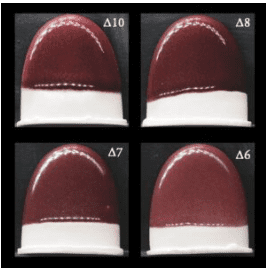We continue the conversation about Cone 6, from our online workshop. “The Middle Glazes: The Story of Cone 6 Glazes…
This time we are looking at how temperature effects a glaze. Above you will see four glazes, but they are all the same glaze. This is a Cone 10, Chrome-Tin Red Glaze that we developed. Its a slight tweak on CMW Gilbert’s Red, which you can find here https://glazy.org/recipes/26657. This glaze is designed to be a Cone 10 glaze, and that is the test in the upper left corner.
In this test we took this glaze and simply fired it at lower and lower temperatures, Cone, 8, 7, and 6. As you can see, the glaze has some of the characteristics of the original glaze. They are all red, which is good. But if you look closely you will see, that as the temperature goes down, the glaze goes from highly glossy to dull.
This is a great representation of the melting process because you are seeing the glaze melt. At Cone 6, the glaze is simply underfired, full stop. Some might want to call this glaze “Matte” but is absolutely not, it is underfired.
The tile on the lower right, represents a hue problem with a lot of “Matte” glazes. Quite often we hear the phrase “My matte glaze gets glossier, if I fire it a little hotter” What that means is that you don’t have a “Matte” glaze, you have an underfired glaze. If you didn’t know what you are looking at, you could very easily call the lower right a matte glaze, but in reality it is just an underfired glaze.
So how do we get temperature down??? How do we know if out glazes are Matte or underfired??? Check out our workshop The Middle Glazes!
Want to Learn More? Join Our Community
Become a part of our community of passionate ceramicists. Explore our online courses and workshops, follow us on social media @ceramicmaterialsworkshop, and sign up for our newsletter. Together, we can build a community of informed and empowered ceramic makers who value quality and craftsmanship.
Have a few more minutes? Check out our YouTube channel to the right for a Free Glaze Chemistry Lesson from The Middle Glazes workshop. We add new videos frequently, so make sure that you subscribe to be notified when we add new content.

